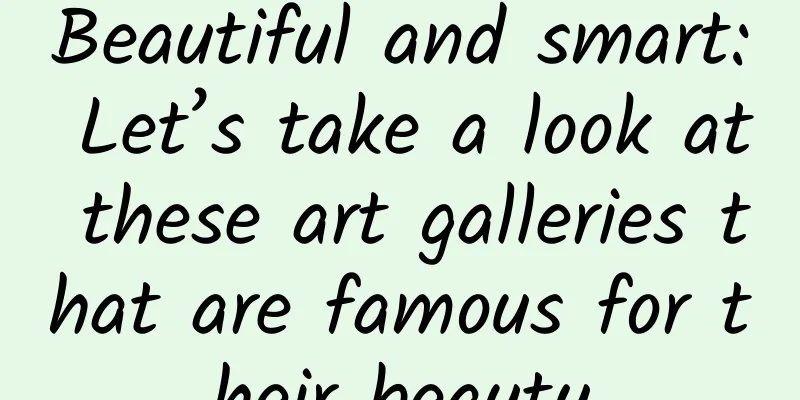Beautiful and smart: Let’s take a look at these art galleries that are famous for their beauty

|
The construction of art galleries is closely related to urban development, because art galleries often carry the spiritual space, historical space and aesthetic space of a city, and can better reflect a city’s attitude and taste towards culture. Therefore, the requirements for site selection and design are particularly high. Sometimes an art gallery is a local landmark building, thus becoming a place for many people to check in. Song Art Museum Speaking of distinctive art galleries, an art gallery on the quiet Wenyu River in Shunyi, Beijing, is impressive. The white geometric building is surrounded by green land, which makes it look spacious, simple and high-end. The whole group of buildings has a strong Victorian style, but the charm it shows belongs to the East. When you are here, you can see pine trees everywhere, and the pine wind is refreshing. This dreamlike place is the Song Art Gallery founded by Wang Zhongjun, the founder of Huayi Brothers, and designed by the famous designer Zhou Guangming. Song Art Museum covers a total area of more than 22,000 square meters, with an indoor exhibition area of approximately 2,200 square meters. It has a total of 12 exhibition halls and was officially opened in September 2017. In the extensive and profound Chinese traditional culture, the "pine", one of the three friends of winter, is pure and majestic, symbolizing the character of a gentleman and is admired and loved by people. "Pine" has become the spiritual symbol of Chinese literati for thousands of years, which is also the character that Wang Zhongjun likes and is fascinated by, so he asked to plant 99 pine trees of various shapes around the art gallery, but found that it was not enough, so he added 100 more, from tree shape to height to color, etc., all carefully selected, a total of 199 trees, to form the current atmosphere. These pine trees in the art gallery space have different shapes and are full of tension. They are also like pieces of art, full of the connotation of nature and life, which echo and contrast with the art exhibits in the exhibition hall. Against the backdrop of green grass, the art museum forms a relationship of both harmony and intense conflict with the various vigorous pine trees that can be found everywhere. It is completely integrated with the environment without any sense of incongruity. The theme of "pine" has undoubtedly opened up a new track for China's current art museums, and one can't help but marvel at the wonderful design ideas. Long Museum Located on Longteng Avenue in Xuhui District, Shanghai, Long Museum (West Bund) is a private art museum founded by famous Chinese collectors Liu Yiqian and Wang Wei. It was officially opened in March 2014. The biggest highlight of this museum is that it retains the original dock structure "coal hopper", and then the space constructed purely with concrete structure and materials presents a charm of primitive and modern collision. The West Bund in Shanghai is one of the birthplaces of modern Chinese national industry. The Long Museum (West Bund) was built on the site of the former Beipiao Wharf. It was established as an urban public project and together with other residences, leisure places and shopping facilities on the West Bund, it constitutes the "West Bund Cultural and Art Circle" in Shanghai. The Long Museum (West Bund) was designed and built by Chinese architect Liu Yichun, with a total construction area of 33,000 square meters and an exhibition area of 16,000 square meters. Just as successful art galleries in the world all have an attractive appearance, the exterior design of the West Bund Museum also has a striking effect. The main building is constructed with a unique "umbrella arch" structure and is cast in gray concrete. It is full of the unique feelings of the industrial age and gives people a sense of time travel. The building is divided into four floors. The large-scale arched space on the first and second floors above ground is cast with fine-textured plain concrete, forming a visual echo with the fashionable space "Doulang" transformed from the original Beipiao Wharf structure "coal funnel", creating a rational and calm industrial and primitive sense, as well as a contrasting sense of power and lightness, while giving the museum building a very keen sense of contemporaneity and creativity. The underground floor returns to the traditional "white box" rectangular exhibition space. The whole building is majestic and grand, no longer a closed and introverted art museum space model, but is more open and public-participatory in its functional design. There are multiple exhibition halls in the museum, which interpret the connotation of dragon culture from different aspects and let the public understand the differences and commonalities of dragon symbols in different cultures. Lava Art Museum The Lava Art Museum is located in the National Mountain Outdoor Sports Demonstration Park in Anlong County, Qianxinan, Guizhou Province. It is the first art museum on a cliff in China. It is in a unique location. From a distance, it seems to be suspended above a 100-meter cliff, showing the public in a thrilling, beautiful and dignified way. The Lava Art Museum is small and exquisite, with a construction area of 1,350 square meters and an internal area of 800 square meters. It has three floors. For an art museum, it is indeed not grand enough, but fortunately it does not care about size at all, but wins by taking risks. The cliff under the Lava Art Museum is about 165 meters high, which is about as high as more than 50 floors. The museum is built according to the terrain of the natural collapse area at the top of the cliff. The design uses a curved half-moon shape, which is embedded in the original collapse area to fill the gap in the cliff. The side of the building facing the canyon uses floor-to-ceiling glass, breaking the boundary of the space. In order to maximize the vision, the beauty of rivers, mountains, strange peaks and rocks can be seen at a glance, allowing the audience to directly feel the magnificence of nature from a bird's eye view. The exhibits in the museum can produce a peculiar visual experience against the background of this natural beauty. At night, the glass building is brightly lit, as bright as the starry sky, embellishing the edge of the cliff like a poem and a painting, which makes people trance. The entire art museum is integrated with the mountain, and the glass material and the karst mountain are contrasted to highlight the beauty. This fusion of art and nature makes the art museum not only a building, a platform for spreading art and culture, but also a work of art worth collecting. Sifang Art Museum A building made of several large containers seems to be suspended in the air. The long staircase goes up from the bottom to the top, and walking on it feels like walking into the unknown... The integration of different spatial levels and building materials with natural landscapes presents a deep and mysterious spatial feature. The environment is particularly intoxicating in spring. This is the Sifang Contemporary Art Museum. Sifang Art Museum is located on the shore of Foshou Lake in Pukou District, Nanjing, on a 47-hectare empty forest in the suburbs of Nanjing. Designed by the famous American architect Steven Holl, it is one of the "China International Architecture Art Practice Exhibitions" and is adjacent to 24 masterpieces of architectural masters. The project took 10 years to complete. As the core of the project, Sifang Art Museum, with an exhibition area of 2,000 square meters, officially opened in November 2013. The design of the museum is composed of a "field" of parallel perspective space and a black concrete garden wall made of bamboo. From a distance, it looks like a white box inserted into the mountains, and a lightweight body suspended above the garden wall. Its design forms different viewing angles due to the staggered spatial levels. At the same time, it is combined with the surrounding gardens and waters, and the black and white colors are used to perfectly interpret the mystery of the East. This rural site is connected to the visual axis of Nanjing, the great capital of the Ming Dynasty, adding a touch of urban style. Sifang Contemporary Art Museum is also known as the most beautiful mountain art museum. Tang Yongming |
<<: The physics giant who defended the molecular theory fell on the eve of dawn...
Recommend
Little Red Book Promotion Notes Marketing Strategy!
If you ask me which platform users enjoy watching...
Beware! The Shanxi express delivery epidemic has spread to 4 places! Please check this reminder →
The epidemic related to Yunda Express in Shanxi P...
A microwave oven is the key to 2-nanometer chip manufacturing
A home microwave oven modified by scientists is h...
How to place, operate and optimize Toutiao ads?
The first step in Toutiao advertising: understand...
Android Gradle from understanding to practice
Preface The previous article gave an overview of ...
Fan Jian's "Latest Taobao Tmall Courses" series of tutorials to increase conversion rate by at least 200% (Advanced)
Course Contents: Lesson 1: Completely restore the...
World Water Day: Here’s what you need to know about groundwater
There is a kind of water, deep underground It is ...
An article explains the six major operating trends of APP in 2017!
For mobile market APPs, the coverage rate of mobil...
Why is the eighth season of The Big Bang Theory the first aesthetic drama?
At the end of last year, a "foreign restrict...
Did the solar system originate from a "floating cloud"? The scientific truth about the birth and evolution of the universe
Mainstream astronomers and astrophysicists agree ...
Why is it that no one is interested in the product even though we have exhausted all kinds of marketing methods?
I have learned all kinds of clever marketing tech...
Wuling Motors: Wuling Silver Label sales reached 69,364 units in March 2025, up 166% year-on-year
Recently, Wuling Motors announced that in March 2...
It is a striking orange color, why is it called a "black box"?
Black Box Flight Data Recorder Can record the air...
Li Enlin, "The Innovation and Expansion of Songcheng Performing Arts' "One Play""
Li Enlin's "Songcheng Performing Arts: I...
Extending the life expectancy of mice and monkeys? You can get this health "all-rounder" with just a little effort!
If you say there is something that can resist agi...









![Toutiao Information Flow Luban Introductory Course [Basic Concepts] Tutorial](/upload/images/67cc4eb1e43e0.webp)